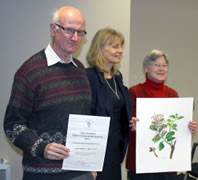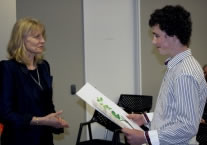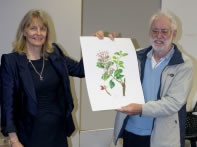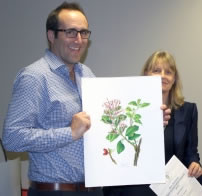From wetlands in the Waikato to the drylands of Canterbury, and from kakabeak on the cliffs of Hawkes Bay to the urban forests of Wellington and Auckland, this year’s Plant Conservation Network awards span the full breadth of activity required to protect New Zealand’s native plants.
The 2013 award winners are:
- Individual involved in plant conservation: Jan Simmons (Hamilton)
- Community Plant Conservation Project:Otari-Wilton’s Bush Trust (Wellington)
- School Plant Conservation Project:Vogeltown Primary School (New Plymouth)
- Young Plant Conservationist of the Year: Tim Logan (Christchurch)
- Lifetime Achievement Award: Mike Wilcox (Auckland)
- Special Award: Forest Lifeforce Restoration Trust (Hawkes Bay)
- Special Award: John Sawyer (Auckland)
 Individual
Individual
Jan Simmons promotes planting of native species in and around Hamilton. Jan has published a book on New Zealand wetlands. She helped establish the Tamahere Community Nursery, which provides eco-sourced plants for the Hamilton gully project, the Waiwhakareke, the National Wetland Centre at Lake Serpentine and other projects. Jan will lead a group of volunteers to collect seeds of the more difficult to locate and grow species.
 Community Project
Community Project
Wilbur and Liz Dovey, members of the Otari-Wilton’s Bush
Trust in Wellington, organise monthly weeding bees, arrange for any new plants, and have purchased tools for the team. They weed around young plants, fill planting gaps, and control weeds. This team of volunteers has visited the gully every month since 2007 and have restored 20ha of a once weed choked gully into alowland coastal forest.
School Project
Vogeltown School in New Plymouth is helping to look after the Huatoki Domain. One class adopted a focus on swamp maire; waiwaka in Taranaki. There is only a small population, with little or no natural regeneration. The children collect seed, propagate this, and plant them in the domain. They have planted 50 waiwaka so far, with more to come. They also undertake weeding, share their knowledge about propagation, and provide guided tours. The first class of children has moved on, but current classes are continuing with equal with enthusiasm.
 Young Conservationist
Young Conservationist
Tim is a 15 year old Darfield High School student passionate about NZ native species; particularly dryland plants. Tim has establish his own ‘Greendot’ site as part of the TeAraKakariki Greenway Network. Planting is nearly complete at this site. He developed a site and management plan to ensure his plants were well suited to the site, including a rockery to provide habitat for rare dryland herbs and brooms. Tim is now looking to research factors which may hinder regeneration of dryland plants. His passion and enthusiasm are so great that he has been nicknamed “the next Colin Meurk”!
 Lifetime Achievement
Lifetime Achievement
Mike has been the president of the Auckland Botanical Society for 10 years. He has been the leader of numerous botanical fieldtrips, both locally and overseas. He is edited the definitive book on the Natural History of Rangitoto and has published a book called Auckland’s Remarkable Forest and is currently preparing a book on the marine algae of Auckland. He is an Honorary Research Associate at the Auckland Herbarium and a local an authority on monocotyledons, especially grasses.
Special Award
One of the Hawkes’ Bays’ Forest Lifeforce Restoration Trust projects is to increase the wild population of kakabeak (Clianthus maximus) in the Maungataniwha Native Forest. They collect seeds and plants are grown within two enclosures exclude browsing animals and established a nursery population in a safe location. They have trialed a ground-breaking technique to establish kakabeak in remote and difficult to access places (for herbivores too) by blasting seeds into soil with a shotgun from a helicopter. They undertake Pinuscontorta and possum control at Pohokura to help protect Pittosporum turneri.
 Special Award
Special Award
John Sawyer has stepped down from the NZPCN, and is moving to Edinburgh. He had a major role in starting the NZPCN and has been the driving force behind setting up and managing the website. John’s ideas and hard work have hugely increased the popularity of NZPCN. He obtained funding to improve the website and other Network projects. He initiated and carried out work towards the Global Plant Conservation Strategy goals, including the establishment of a seed bank in NZ, development of marae based plant conservation courses, and the NIWA aquatic weeds project.
